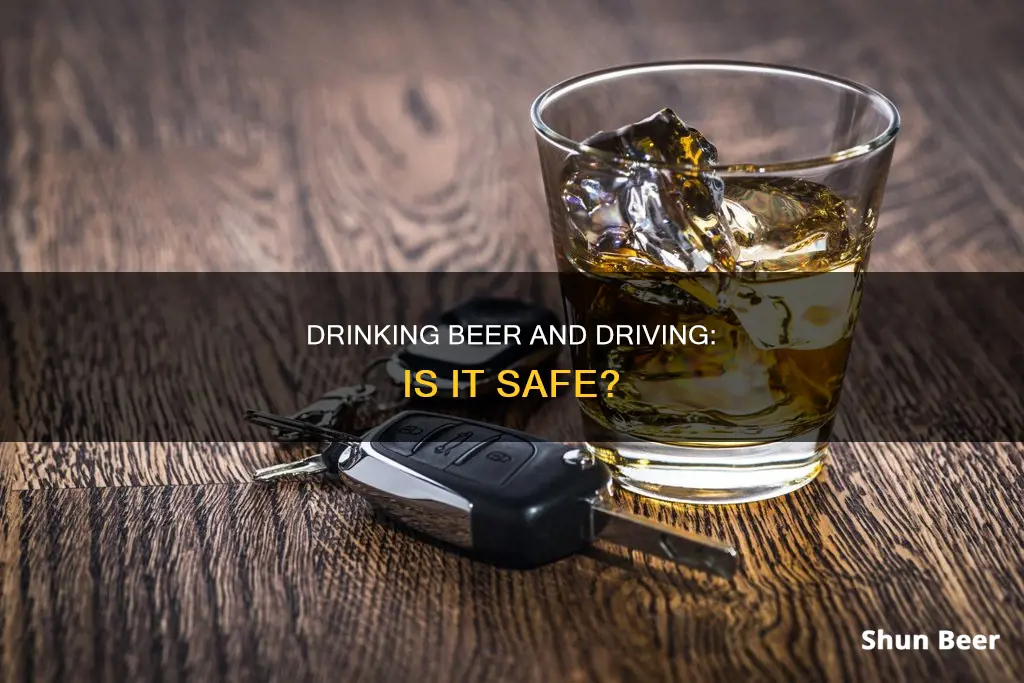
Drinking and driving is a serious issue that can lead to accidents, injuries, and even fatalities. While the legal blood alcohol content (BAC) limit for driving in most places is .08%, the number of drinks it takes to reach this limit varies by individual factors such as weight, gender, metabolic rate, and food consumption. Generally, a 140-lb woman can consume up to 2.5 regular 12-ounce beers in an hour and maintain a BAC below the legal limit, while a 180-lb man may be able to drink up to 3.5 beers. However, it is important to note that these are just estimates, and drinking any amount of alcohol can impair judgment and increase the risk of accidents. The safest option is to avoid drinking and driving altogether and to utilize alternatives such as designated drivers, public transportation, or ride-sharing services.
What You'll Learn

Variables that affect Blood Alcohol Content (BAC)
Drinking alcohol and driving is a dangerous combination. While it may be common in some cultures, it is important to understand the variables that affect Blood Alcohol Content (BAC) to make informed decisions about drinking and driving. Here are the key variables that impact BAC:
Weight and Body Composition
Weight plays a significant role in BAC levels. Individuals with a larger body weight tend to have more water in their bodies, which dilutes the alcohol and results in lower BAC levels compared to those with a lower weight. Additionally, body composition, including the percentage of body fat and lean body mass, is important. Alcohol can enter most tissues except bone and fat, so as body fat increases, the concentration of alcohol in the lean tissues increases proportionally.
Amount and Speed of Consumption
The amount of alcohol consumed and the speed of consumption directly impact BAC levels. The more alcohol consumed within a short period, the higher the BAC will be.
Food Intake
Consuming food before or during alcohol consumption can affect BAC levels. Food in the stomach slows down the absorption of alcohol into the bloodstream, potentially lowering the peak BAC. However, the type of food (carbohydrates, fat, or protein) does not seem to have a significant influence on BAC.
Carbonated Beverages
Carbonated beverages, such as mixing alcohol with soda or tonic water, can increase the speed of alcohol absorption into the bloodstream, leading to higher BAC levels.
Gender
Men and women metabolize alcohol differently due to differences in body composition and enzyme production. Women tend to have lower levels of alcohol dehydrogenase, the enzyme that metabolizes alcohol, resulting in alcohol remaining in the bloodstream longer. Additionally, women typically have a higher percentage of body fat, further influencing BAC levels.
Age
Age can also impact BAC levels. After consuming an alcoholic beverage, older adults tend to have higher BAC levels compared to younger adults.
Genetic and Biological Factors
Genetic and biological factors can influence BAC levels. Individuals with a family history of alcoholism may have an increased risk for developing alcoholism themselves. Additionally, certain ethnic groups, such as those of Asian or Native American descent, may have reduced levels of alcohol dehydrogenase, leading to alcohol remaining in the blood longer.
Sleep and Fatigue
Lack of sleep or fatigue can lower an individual's tolerance to alcohol. As a result, impairment will be experienced at lower BAC levels than usual.
Drug Usage
Mixing alcohol with certain drugs, such as marijuana or over-the-counter painkillers like aspirin and ibuprofen, can impact the body's ability to process alcohol effectively, leading to increased impairment.
It is important to note that while these variables influence BAC levels, individual responses to alcohol may vary. Additionally, legal limits for BAC while driving vary by region, so it is essential to be aware of the specific laws in your area. Making informed decisions about drinking and driving can help ensure the safety of yourself and others.
Drinking Non-Alcoholic Beer While on Metronidazole: Is It Safe?
You may want to see also

Metabolising alcohol
Whether or not you can drink 2 beers and drive depends on a variety of factors, including your body weight, gender, metabolism, and the time elapsed since drinking. The general rule of thumb is that it takes about one hour for the average person to metabolise one standard drink. However, this can vary depending on factors such as age, body fat percentage, and gender.
When you drink alcohol, it enters your stomach and then travels to your small intestine. About 20% of alcohol is absorbed through the stomach, while the majority is absorbed through the small intestine. A small amount, about 10%, is eliminated through your breath, sweat, and urine.
Alcohol is primarily metabolised in the liver, which breaks down alcohol molecules into acetaldehyde using the enzyme alcohol dehydrogenase (ADH). Acetaldehyde is then broken down into acetate, which is further metabolised into water and carbon dioxide before being eliminated from the body. The liver can only metabolise a certain amount of alcohol per hour, so if you consume more than one standard drink per hour, the additional alcohol remains in your bloodstream and body tissues, leading to drunkenness.
The rate at which alcohol is metabolised can vary depending on several factors. For example, women tend to have higher blood alcohol levels than men after consuming the same amount of alcohol. This is because women typically have a higher body fat percentage, and fat absorbs alcohol from the blood at a lower rate than muscle. Age also plays a role, as older adults tend to have a higher blood alcohol concentration (BAC) than younger people after drinking the same amount.
Consuming food before or while drinking alcohol can also affect the rate of metabolism. Food in the stomach slows down the absorption of alcohol, reducing the peak blood alcohol concentration and metabolism rate. Additionally, medications such as blood pressure medication, antidepressants, muscle relaxants, and anti-inflammatory drugs can affect how the body metabolises alcohol.
In summary, the number of drinks, your individual characteristics, and other factors will influence whether or not you can drink 2 beers and drive safely. It is important to remember that drinking any amount of alcohol can impair your judgment and coordination, so it is always best to err on the side of caution and avoid driving if you have been drinking.
Beer and Rifampin: Safe or Not?
You may want to see also

Drunk driving laws in the US
The National Highway Traffic Safety Administration (NHTSA) estimates that about 37 people in the US die in drunk-driving crashes every day, which is approximately one person every 39 minutes. In 2022, there were 13,524 deaths caused by drunk driving, and alcohol-impaired driving accounted for about 32% of all traffic crash fatalities in the country. The financial impact of drunk driving is also significant, costing the US $68.9 billion annually.
The effects of alcohol on driving ability are well-known. Alcohol is a substance that reduces brain function, impairing thinking, reasoning, and muscle coordination, all of which are essential for safe driving. As alcohol levels rise in a person's system, the negative effects on the central nervous system increase, leading to impaired judgment, reduced coordination, and slower reaction times.
While the legal BAC limit is consistent across the US, the specific drunk driving laws can vary by state. Some states impose minimum jail time, minimum fines, and minimum license suspension periods for drunk driving offenses. Many states also require the installation of ignition interlock devices, which are in-car breathalyzers that prevent the vehicle from starting if the driver's BAC is above a pre-set low limit.
It is important to note that even if your BAC is below the legal limit, you can still be charged with a drunk driving offense if there is evidence of impairment. Additionally, the type of alcohol consumed, the number of drinks, the speed of consumption, gender, weight, and food intake can all impact a person's BAC and level of impairment. Therefore, it is always best to avoid driving after consuming alcohol and to plan for alternative transportation methods, such as a designated driver, taxi, or ride-hailing service.
Beer Drinking: Weight Loss Friend or Foe?
You may want to see also

Drunk driving laws in Canada
In Canada, it is a criminal offence to drive with a blood alcohol concentration (BAC) of 0.08 or higher, which is equivalent to 80 milligrams of alcohol in 100 millilitres of blood. Drinking drivers with lower BACs are dealt with under provincial and territorial traffic acts.
Canada's drunk driving laws are considered to be among the strictest in the Western world. The mandatory minimum fine for a first offence is $1,000, and the maximum prison term for a summary conviction is 18 months. The mandatory minimum prison term for a second and subsequent offence is 30 days.
In addition to criminal penalties, Canada imposes a driving prohibition of one to three years for drunk driving offences. This means that convicted individuals will have their driver's licence suspended for a period of time, depending on the severity of the offence.
Canada has also implemented mandatory alcohol screening, which authorizes law enforcement officers to demand a roadside breath sample from drivers, regardless of whether they suspect the driver has been drinking. This measure aims to deter and better detect alcohol-impaired drivers.
Furthermore, recent reforms to Canada's impaired driving laws have eliminated certain defences that encouraged risk-taking behaviour, such as the "bolus drinking" defence, where individuals claimed that their BAC was still rising at the time of driving, and the "intervening drink" defence, where individuals consumed alcohol after driving but before providing a breath sample.
Overall, Canada takes drunk driving offences very seriously and has strict laws and penalties in place to deter and punish such behaviour.
Beer and Kidney Cysts: What's Safe to Drink?
You may want to see also

Consequences of drinking and driving
Drinking and driving is a serious issue that can lead to several consequences. Firstly, it is important to understand that drinking alcohol can impair your judgement, coordination, and concentration, making it unsafe to operate a vehicle. Alcohol slows down your reaction time, affects your vision, and impairs your ability to make quick decisions, all of which are crucial for safe driving.
The legal consequences of drinking and driving can be significant. In most places, it is illegal to drive with a blood alcohol content (BAC) of 0.08% or higher, and the penalties for doing so can include driver's license suspension or revocation, vehicle license plate confiscation, and even jail time. Higher insurance rates and financial fines are also common outcomes. These consequences can have a significant impact on your life, affecting your family, relationships, employment, and financial stability.
Drinking and driving not only puts yourself at risk but also endangers the lives of others. It is one of the leading causes of motor vehicle accidents and fatalities worldwide, with thousands of deaths and injuries occurring each year due to alcohol-impaired driving. The emotional burden of causing harm or death to others while driving under the influence can be devastating and life-altering.
Additionally, drinking and driving can have legal, financial, and professional ramifications. A single drunk driving infraction can lead to job loss or restrictions, such as the inability to operate company vehicles. The financial burden of higher insurance rates, fines, and legal fees can be significant, and the impact on your professional life can be long-lasting.
To avoid the consequences of drinking and driving, it is important to always plan ahead. This includes designating a sober driver, abstaining from alcohol if you are the designated driver, and utilizing alternative transportation options such as taxis or ridesharing services if you have been drinking. Remember, any amount of alcohol in your system can impact your driving ability, and it is never worth the risk to yourself and others.
Crafting the Perfect Black and Tan Beer Drink
You may want to see also
Frequently asked questions
It depends on many factors, including your weight, gender, metabolic rate, and the ABV of the beer. In the US, the legal limit for Blood Alcohol Concentration (BAC) is .08%. According to some estimates, a 140-lb woman can consume 2.5 regular beers in an hour and maintain a BAC of less than .08%. However, it is important to note that these are general estimates, and individual factors can significantly impact BAC levels.
Various factors influence your BAC level, including your weight, gender, metabolic rate, the amount of food consumed, and the time of day. Additionally, craft beers with a high ABV can contain a significantly higher amount of alcohol, affecting your BAC level.
The National Highway Transportation Safety Administration (NHTSA) in the US uses .08 as the uniform BAC limit across all 50 states. This limit is based on the number of drinks consumed and individual factors. It's important to note that impairment can begin after the first beer, and calculations from NHTSA should be used for estimation.
It is generally recommended to avoid driving after drinking and to use alternative options such as Uber or a designated driver. While there are estimates and calculations to predict BAC levels, they may not always be accurate due to individual variations. The safest option is to refrain from driving if you have been drinking.
Drinking and driving is illegal and dangerous. It can lead to arrests, injuries, and even fatalities. Thousands of deaths and injuries occur each year due to drunk driving. It is essential to make alternative arrangements if you plan on drinking to ensure the safety of yourself and others.







